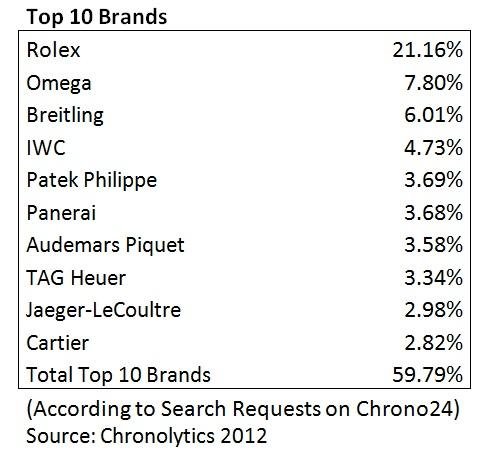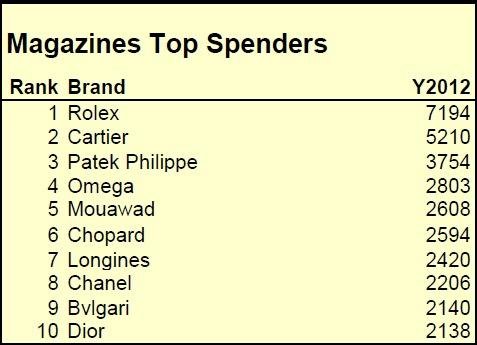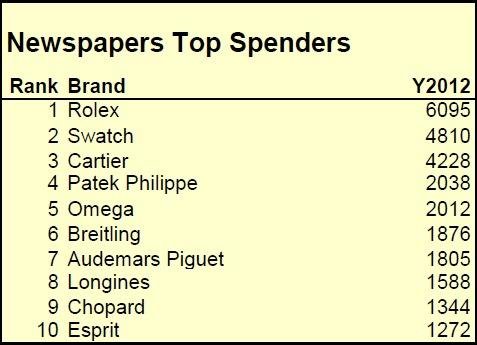Introduction
Marketing strategy of a company, in practice and theory, is often replete with gaps. Often, marketers have deviated from the theoretical principles to develop their own set of rules that they have dubbed more useful in marketing and selling their product.
This paper is a case study analysis of Rolex. The main objective of the paper is to ascertain the gap in the marketing strategy and principles adopted by Rolex with that of the theoretical marketing framework presented by McDonald and using anatomy of world class marketing.
WCM
This analysis is done using the 10 points of world class marketing developed by Malcolm McDonald. The first point shows the market orientation of the company. The first point entails that it is the work of the company. It is the job of the top management to instill among its employees the ideal of customer orientation.
In other words, customer orientation has to be enhanced in order to ensure greater possibility of creating products that would satisfy the customers. In case of Rolex, the company has historically paid a lot of attention to the product that they created. As the company sells luxury products, it makes sure that all the qualities of luxury are presented in the watches crafted by the company.
Further, the customers should be made a vehicle for promotion. This can be attained only by making high quality products. A high quality product that satisfies the customers exceedingly would ensure that he/she promotes it to his/her peers. Rolex has achieved this through its quality and brand name. Thus, the first point of McDonald has been satisfied by Rolex’s marketing strategy.
Rolex is a luxury watchmaker. The company is famous for its unique targeting, segmenting, and positioning of their product. However, with the change in the generations and ushering of the new generation who is more inclined towards new fast moving technology than a timeless timepiece, Rolex faces a challenge as to how they can attract these new emerging customers. In this section, we will first discuss the marketing strategy of Rolex.
Usually companies carry out extensive research and analysis before formulating the four Ps of marketing – price, promotion strategy, place, and product. We undertake a thorough research of the marketing strategy and mix of Rolex.
The target customers for Rolex are both male and female. Targeting both the demographic section is advantageous and helps the company to spread its market.
Rolex’s advertising strategy entails celebrity endorsements. In order to cater to a certain economic class the company meticulously positions itself targeting the rich and the ones who crave for “class” rather than “beauty” . This is evident from the taglines used in previous Rolex advertisements such as “Class is forever” .
The products that are presently marketed by Rolex can be broadly divided into three collections – Oyster collection, new 2013 collection, and Cellini Collection. The oyster collection boasts of “elegance and prestige” and has twenty models in the collection.
The second collection is the new 2013 collection of Rolex is a new collection of chronometers with cutting-age technology instilled in them to attract the new generations and retaining their old classiness. The third collection is the Cellini collection .
The second point as enumerated by McDonald is to understand the sources of competitive advantage for the brand. McDonald has segregated this into three categories – superior position, skills, and resources. Superior position entails niche products with high degree of differentiation and concentration on pricing. The products are positioned in a niche market as luxury brand with high pricing.
The watches sold by Rolex are priced high. The pricing strategy goes with their promotion and positioning strategy. Further, as their products are made with very expensive raw material and they happen to be fitted with the best quality technology. The high price is equivalent to the positioning of the product as a luxury item.
Understanding the environment of the company has a specific implication on the marketing strategy of the company. An analysis of the macro and the microenvironment helps to ascertain the threats and opportunities that are present for the brand in the market.
In case of Rolex, the threat is the aging demographics of the target market of the brand. With aging population, the taste and preference of people are changing considerably, which has inculcated a threat to the organization’s product demand . Thus, the aim of Rolex should be to target younger target market
Luxury brands have swept over to the emerging economies. All marketers of different luxury items from automobiles to wristwatches have started targeting the developing, emerging market of the Asian giants like China and India . According to the predictions of analysts by 2018, Asia Pacific will be biggest market for luxury goods . This presents a unique opportunity for luxury watch brands.
The fourth point that is enumerated is to understand one’s competition. The company should categorically understand who their direct and potential competitors are. Further, they should also be aware of the substitutes, backward and forwards integration competitions, and of the competitor’s strength and weaknesses.
The major potential of Rolex is that it is in the luxury brand market, which is highly driven by brand loyalty and recognition. The direct competitors of Rolex are other brands like Omega, Longines, Cartier, Chanel, Patek Philippe, etc.

Further, Rolex faces the threat of fake products in the market. This provides a stiff competition in price-sensitive Asian markets.
The fifth is to understand the market segment. The market segment that the company has placed its product in is the luxury market, and the prices are high as they are placed in the luxury market. Rolex watches are branded as a symbol of superiority.
For instance, older advertisement campaigns of the company had tag lines like “If you were looking for lost empires here tomorrow you’d wear a Rolex” . The positioning of the products is that of excellence and symbol of success. The promotional strategy of Rolex can be categorized into following classes –
- Advertisements in televisions.
- Print advertisements in magazines and newspapers.
- Sponsors of gaming events like Wimbledon.
- Embedded advertisements in movies like those of James Bond.
In television, the advertisements are usually placed in the lifestyle or sports channels showing major sporting events like tennis and golf. Usually Rolex advertisements accompany airing of James Bond movies. Rolex spends most in newspaper and magazine advertisements.
Promotions help companies to familiarize their products to the customers. However, what is promotion to a luxury brand like Rolex? The promotional strategy of Rolex is to sell the idea of the class that Rolex attaches to itself. Rolex is not promoted as just a brand, but as a way of life, as class, as society.
For instance, the Oyster models of Rolex was first introduced in 1926 as the first waterproof watches and since then has clad the wrists of many famous personalities but as timeless is the brand the essence of the clean, utilitarian design of Rolex has not lost its edge .
The tables below show advertisement expenditures of Rolex and its competitors in magazines and newspapers.


The sixth point is ascertaining the strength and weakness of the brand. In this case, Rolex’s strength is its product’s unique style and positioning. The weakness of the brand is its present appeal to the older target customers, and inability to target newer generations.
The seventh point is to understand the dynamic market for the product, i.e. to conduct a life cycle analysis. Life cycle analysis helps in ascertaining the position in the life cycle where the product lies.
The eighth point suggested by McDonald is to have a strong portfolio of products. The products that are offered by Rolex are unique and timeless. Their appeal is great as each are made differently and crafted in different styles.
The ninth point shows that a company should formulate a strategic marketing policy and stick to it. In case of Rolex, the company has adhered to its niche marketing strategy since the beginning and therefore its charm and demand has not faltered.
The last point presented appeals to the companies to maintain a professional attitude in promoting and marketing its products. It is important for the company to understand all the above marketing tools and continually evaluate its products using these tools in order to make predictions of any impending changes in future.
Marketing Leadership Council (MLC)
Marketing leadership council is the new-age marketing tool that helps marketing leaders to change the way they have so far addressed the long-standing conventional wisdom. MLC is usually associated with the corporate executive board. The main areas that the MLC program looks into are – research, peer benchmarking, networking, online learning, best practices, support system, and diagnostic tools.
The main aim of the council is to help its members to benchmark their performance, risk factors, operational process, human resources, and transition of leadership. The MLC has provided certain aspects of business through their researches, which helps companies to benchmark their performance. This model enumerates the need to enhance presence in social media.
They believe more customers can be influenced through promotions in the social media. In case of Rolex, the presence of the company remains scant in any of the social networking websites. Very few online campaigns have been launched by Rolex so far.
One reason may be that the target customers are not same as the social network users. However, one must note that in order to target newer generations, Rolex must embrace innovative methods of marketing that other companies have already started to embrace.
The idea of MLC is not to teach the customers but to un-teach them. MLC dictates that marketers should strive to un-teach what customers already know about the product or brand. However, in case of Rolex, this rule may not apply, as the basis of Rolex’s success is what the customers already know about the brand.
Un-teaching that would deplete their existing brand name. the idea of the company was to make sure that the perception of the customers is properly molded through previous advertisements, which, unfortunately, the MLC model suggests to change. Therefore, this differs from the WCM point, which states that the brand should utilize its core competencies.
In this respect, the question that arises is, if the niche promotional strategy adopted by Rolex following the WCM model is apt for the company today. The question that arises is why does Rolex follow a niche promotional strategy?
The answer to the question is simple – Rolex’s product and positioning does not support and/or demand a mass-marketing strategy. Niche promotional strategy is apt for a brand like Rolex that sells only luxury items and that too, to a niche target market.
Conclusion
The overall analyses of the two models demonstrate that Rolex has been following the WCM model more closely than the MLC model. The WCM model is more theory oriented while MLC is more application oriented. The company’s present marketing strategy demonstrates that they have continued to follow their old strategy and have not undertaken any effort to embrace the new age marketing principles.
This has intensified their problem of targeting new age customers. Based on the above study it can be intuitively said that Rolex needs to change the way their marketing team thinks and perceives their brand.
References
Adams, A. 2013, Wrist Watch Brands & Models Of High Value. Web.
Forster, J. 2012, The Rolex Problem. Web.
Hodinkee 2013, A Quick Look At The New Rolex Ad Campaign: Highlighting Innovators And Rolex Wearers. Web.
Klara, R. 2013, How Rolex Runs on Autopilot Educating is no longer necessary. Web.
McDonald, MHB, Chernatony, L. D. & Harris, F. 2001, ‘Corporate marketing and service brands – Moving beyond the fast-moving consumer goods model’, European Journal of Marketing, vol 35, no. 3/4, pp. 335 – 352.
McDonald, M. & Wilson, H. 2011, Marketing Plans: How to Prepare Them, How to Use Them, John Wiley & Sons, London.
MPP-ME 2013, Advertising Spend (Part 2/5)-Watch & Jewellery Sector Analysis, Web.
Onofrei, I. 2012, How Rolex could become a prisoner of its own strategy, Web.
OyesterInfo 2013, Rolex Advertisments. Web.
Rolex 2013, About Rolex. Web.
Wall Street Week 2013, Emerging Markets Drive Luxury Goods, Web.
Wang, L. 2013, Luxury Sales to Exceed $318 Billion, Driven by Emerging Markets and ‘Affordable Luxury’. Web.